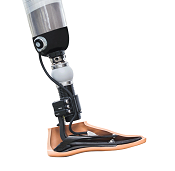Modelo de Prótesis Transtibial Funcional: Aquiles.
Contenido principal del artículo
El presente artículo se expone el diseño de un nuevo modelo de prótesis transtibial, basado en la necesidad de crear un mecanismo que simule el comportamiento anatómico de la articulación tibioperoneo-astragalina, ya que las prótesis existentes siguen presentado
inconformidades en su diseño, funcionalidad, confort y estética. El diseño metodológico está fundamentado en los lineamientos de los niveles de madurez de la tecnología o Technology readiness levels (TRL’s), con el fin de hacer un estudio analítico y a escala, donde se tomaron los niveles TRL 1, TRL 2, hasta la TRL 3. Como resultado se obtuvo una propuesta de un nuevo diseño que aporta una articulación tibioperoneo-astragalina, estabilizadores activos y pasivos y una articulación de los dedos del pie, que aporta una
mejor biomecánica en las fases estática y dinámica de la marcha. La propuesta presenta un modelo novedoso para el mercado, que asemeja la anatomía y respeta la biomecánica de la articulación, generando un menor impacto en el muñón y alteraciones de la marcha.
- Diseño
- prótesis
- miembro inferior
- articulación
(Who), W. H. (2017). Normas de ortoprotésica parte 1. Obtenido de Organización Mundial de la Salud: https://apps.who.int/iris/bitstream/handle/10665/259508/9789243512488-part1-spa.pdf?sequence=1
Miprotesis. (2020). https://miprotesisdepierna.mx. Obtenido de https://miprotesisdepierna.mx/protesis-transtibial/#:~:text=Una%20pr%C3%B3tesis%20transtibial%20se%20trata,el%20tobillo%20y%20el%20pie%2C
Carefirst. (2019). Carefirst.staywellsolutionsonline. Obtenido de https://carefirst.staywellsolutionsonline.com/spanish/testsprocedures/92,P09333
Salgado, S. S. (2012). Alineación en prótesis de miembro inferior. 91.
Argel, D. C.-F. (2005). Niveles De Amputacion. Obtenido de arcesw.com/niveles.htm: http://www.arcesw.com/niveles.htm
Dane. (2004). Departamento Administrativo Nacional de Estadística. 91.
Pitkin, M. (2010). Biomechanics of lower limb prosthetics. Biomechanics of lower limb prosthetics, 0.
Zeng, Y. (2013). Design And Testing Of A Passive Prosthetic Ankle With Mechanical Performance Similar To That Of A Natural Ankle. Marquette University e-Publications@Marquette, 1-86.
Lengua Contrera, L. A. (MAYO de 2016). Modelo de alineación estática para prótesis transtibiales. Tesis doctoral. Bogota: universidad javeriana.
Jinying Zhu, Q. W. (2014). Effects of toe stiffness on ankle kinetics in a robotic transtibial prosthesis during level-ground walking. ELSEVIER, 1254–1261.
Doberti Martinez, A. J. (13 de 10 de 2015). Diseño de una prótesis de pierna para amputados transtibiales. Tesis de pregrado. Santiago, chile: universidad de chile.
Tzinis, I. (2021 ). Technology Readiness Level.
CORPORATION, S. (2006). Conceptos básicos de SolidWorks Piezas y ensamblajes. Estados Unidos: Concord, Massachusetts 01742 EE.UU.
El ministerio de ciencia, t. E. (2021). Niveles de madurez tecnológica (trl) y de manufactura (MRL). Bogota: Minciencias. Obtenido de https://minciencias.gov.co/sites/default/files/upload/convocatoria/anexo_9_-_niveles_de_madurez_tecnologica_y_de_manufactura-_trl_y_mrl.pdf
NASA. (2012). Niveles de madurez de la tecnología. 165-193.
Quintana, J. M. (2020). TRLs o Technology Readiness Levels,. HORIZON. Obtenido de https://www.mincotur.gob.es/publicaciones/publicacionesperiodicas/economiaindustrial/revistaeconomiaindustrial/393/notas.pdf
Solidworks. (2023). Dassault Systèmes SolidWorks Corporation. Obtenido de https://www.solidworks.com/es
Mirlisenna, G. (22 de Enero de 2016). Esss. Obtenido de https://www.esss.co/es/blog/metodo-de-los-elementos-finitos-que-es/
Bassi, G. P. (2010). DASSAULT SYSTEMES. Recuperado el 13 de julio de 2017, de DASSAULT SYSTEMES: http://help.solidworks.com/2010/spanish/SolidWorks/cworks/LegacyHelp/Simulation/Checking_stresses/prot_vonm.html
JR, F. M. (30 de mayo de 2015). PREZI. Recuperado el 14 de julio de 2017, de PREZI: https://prezi.com/o9rc4nxf9l6c/modelo-de-young/
Diaz Montes, J. C. (2009). Mecanismos de transmisión y actuadores utilizados en prótesis de mano. Recuperado el 18 de julio de 2017, de https://diccionario.motorgiga.com/diccionario/elasticidad-de-los-materiales-definicion-significado/gmx-niv15-con193952.htm
Sicma21. (28 de Octubre de 2022). Sicma21. Obtenido de https://www.sicma21.com/que-son-los-actuadores-en-la-industria/
Kapandji. (2012). Fisioloía Articular. Panamerica.
Phil Anderson Pontoja-Caicedo, R. E.-B.-M. (30 de Abril de 2020). Diseño axiomático de un mecanismo pie-tobillo de una prótesis transtibial en el contexto colombiano. (U. d. Escuela de Ingeniería Mecánica, Ed.) Revista UIS Ingenierías, 14. Obtenido de https://revistas.uis.edu.co/index.php/revistauisingenierias/article/view/10535/10507
Bohórquez Vesga, S. A. (2018). Fabricación de un prototipo de una prótesis de miembro inferior transtibial mediante tecnologías aditivas de acuerdo con las medidas antropométricas del paciente. Proyecto para trabajo de grado para la solución de un problema de ingeniería, Universidad Santo Tomás, Cundinamarca , Bogota.
pintherest.eu. (2019). https://pintherest.eu/resultado-de-imagen-de-astr%C3%A1galo-humano-anatom%C3%AD-pierna.html. Obtenido de https://pintherest.eu/resultado-de-imagen-de-astr%C3%A1galo-humano-anatom%C3%AD-pierna.html.
Descargas

Esta obra está bajo una licencia internacional Creative Commons Atribución-NoComercial-CompartirIgual 4.0.
Los autores que publican en esta revista están de acuerdo con los siguientes términos:
Los autores ceden los derechos patrimoniales a la revista y a la Universidad del Valle sobre los manuscritos aceptados, pero podrán hacer los reusos que consideren pertinentes por motivos profesionales, educativos, académicos o científicos, de acuerdo con los términos de la licencia que otorga la revista a todos sus artículos.
Los artículos serán publicados bajo la licencia Creative Commons 4.0 BY-NC-SA (de atribución, no comercial, sin obras derivadas).


 https://orcid.org/0000-0002-7705-7334
https://orcid.org/0000-0002-7705-7334 https://orcid.org/0000-0002-7705-7334
https://orcid.org/0000-0002-7705-7334 https://orcid.org/0009-0000-1248-5816
https://orcid.org/0009-0000-1248-5816 https://orcid.org/0000-0002-2116-4907
https://orcid.org/0000-0002-2116-4907 https://orcid.org/0000-0001-8098-2427
https://orcid.org/0000-0001-8098-2427 https://orcid.org/0000-0001-9681-3089
https://orcid.org/0000-0001-9681-3089


